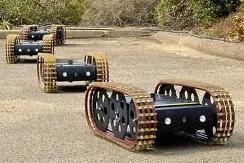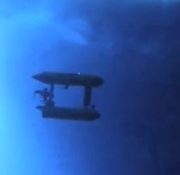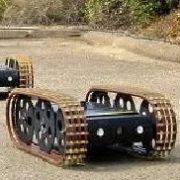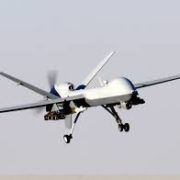 Ground wars are winding down (kind of, maybe), so the speeded-up acquisition process for Unmanned Ground Vehicles (UGV) is slowing down. However, American soldiers are still performing explosive ordnance disposal. Not only do they want their UGVs, but they also want them souped-up with more reliable communications, common controllers, and delivery trucks that automatically unload. And they want them now.
Ground wars are winding down (kind of, maybe), so the speeded-up acquisition process for Unmanned Ground Vehicles (UGV) is slowing down. However, American soldiers are still performing explosive ordnance disposal. Not only do they want their UGVs, but they also want them souped-up with more reliable communications, common controllers, and delivery trucks that automatically unload. And they want them now.
National Defense Magazine published a highly informative article on the disconnect between end-user needs and the acquisition of UGVs. If you want to know about the state of UGV development within each military service, or if you just need another reason to rail against the notoriously slow procurement process, you got to read this article.
(The following article originally appeared in National Defense Magazine as Slow Pace of Robot Acquisition Programs Frustrates End Users.)
Ground robots from the outset of the Iraq and Afghanistan wars were hailed as life-savers and an example of how off-the-shelf technologies could be sped into the field without the cumbersome Defense Department bureaucracy.
Those days are over.
End users of explosive ordnance disposal robots said at a recent conference that the Pentagon’s procurement process is clearly not working for them.
Meanwhile, a Navy EOD program of record to replace the off-the-shelf Talon and PackBot models has floundered. Entering its seventh year of development, it has failed to field its first lightweight robot, and the Air Force recently pulled out of the program, citing delays.
The Army also wants to produce a multi-purpose ground robot, but the earliest it could be fielded is 2021, a senior official said.
“The way the government acquires things through its acquisitions programs has to change,” said Chief Master Sgt. Douglas Moore, an Air Force EOD technician.
In 2007, the Navy, the executive agent for producing bomb disposal robots, embarked on its Advanced EOD Robotic System (AEODRS) program, which would replace its heavy, Andros platforms that pre-dated the post-9/11 conflicts, as well as the off-the-shelf robots that were sped into the field as roadside bombs became a scourge in Iraq.
A Navy official at the National Defense Industrial Association ground robotics conference in San Antonio in 2008 described the family of three robots. The service would develop the system in three increments. Increment 1 would be a backpackable robot in the 35-pound range. Increment 2 would be around 130-pounds, somewhat similar to the size of the widely used PackBots and Talons, which must be transported in a vehicle. Increment 3 would be a large, towable robot intended for large ordnance. The 485-pound Andros robots those would replace are the only ground robot programs of record in the military today. All others were acquired through rapid equipping initiatives.
[layerslider id=”31″]
The next-generation EOD robots would be based on an open architecture system, where components, sensors and tools could be swapped out as needed.
The Navy later announced that vendors would compete for contracts to supply the components rather than a winner-take-all competition to build and integrate the robots.
Six years later, at the same NDIA conference held in College Park, Maryland, the Navy still had not fielded the basic 35-pound robot, and the Air Force said it would no longer participate in the increment 1 program. The Navy finally released its request for proposals for increment 1 components in June.
“By the time we get it, it’s 10-year-old technology,” said Moore, who had heard the program referred to as “abbreviated.”
“I don’t know what ‘abbreviated’ means. But 10 years is not abbreviated for me. Absolutely not,” he added.
The lack of progress on the Navy’s program of record is prompting the Air Force to seek an off-the-shelf robot weighing under 30 pounds. A request for proposals for 160 systems, including 10 years of support, will be released in the first quarter of 2015, according to Robert Diltz, airbase acquisition branch chief at the Air Force Civil Engineering Center.
Moore said: “That is part of the reason why the Air Force pulled out of the AEODRS increment 1 program. One, there were some slippages to the program that put some money at risk, and the technology by the time we would get it would not be what it is today.”
[layerslider id=”33″]
The Army is also looking to field an upgradable robot with open architecture that would be able to perform multiple tasks, said Heidi Shyu, assistant secretary for the Army for acquisitions, logistics and technology. The current timeline would not have it fielded until 2021, and the Army would have to consider purchasing a “stop-gap” robot in the meantime, she said.
Chris O’Donnell, staff specialist at the joint ground robotics enterprise at the office of the secretary of defense, said $1 billion has been spent on ground robots over the past 10 years.
“Unfortunately as the war ended and the [overseas contingency operations] money started to dry up, the requirements weren’t really there to go, ‘Where is the next phase of development for ground robotics?’” he said.
Interest in the technology within the Defense Department remains high, he said. Many senior officers have grown up with ground robots, he noted.
But the services now have to go back to “programs of record” and more rigorous test-and-evaluation standards, O’Donnell said. He listed about a half dozen organizations in the department that will be involved in deciding the future of ground robots in the military, including his own. The purpose of the OSD’s joint ground robotics enterprise is to encourage the services to work together.
O’Donnell was asked in an email after the conference why the Army would take so long to field a robot that, on the surface, sounded identical to what the Navy has spent seven years developing: a standard, open architecture system where components, sensors and tools could be added as needed.
“The Navy and Army technical folks have been working together for the last few years to refine an open architecture that they can both use for future efforts,” he replied. It is called the “unmanned ground vehicle interoperability profile.”
The long-wait periods were because of funding issues, he said. “The DoD funding cycle waits for no one, and the services have done a good job in identifying capability needs and getting those capabilities resourced in the out-year service budgets,” O’Donnell wrote.
It will be his job to ensure the Army and other services leverage the work done on the open architecture system, he added.
Moore was joined on a panel by six other EOD technicians, many of whom had served in both Iraq and Afghanistan and had returned from the war zone within the last six months.
They had a laundry list of features that they would like to see incorporated into current or next-generation bomb disposal robots, although most were cynical that they would see them anytime soon.
Army Master Sgt. David Silva wanted better communications connectivity in his EOD robots. This was an example of something that is available today, but hasn’t found its way to the field yet — at least not for ground robots. He sometimes loses his feeds from his robots after a couple hundred meters.
Meanwhile, an infantryman serving with him hand-launches a light-weight unmanned aerial vehicle “and he’s getting a positive feed and is controlling this thing six clicks away. Clearly it’s not a weight issue. It’s a big robot, and I’m not bound by weight,” he said.
“He has a high-definition feed, and I’m saying ‘What in the world do you have that I don’t have?’”
Moore said he would like to see some basic autonomy. Why can’t operators when arriving on scene push a button and let the robot unload itself from a truck? That would let the team focus on other tasks for 15 minutes.
Cars can parallel park themselves nowadays, he noted. “I’m not exactly sure why we’re not there yet.”
Air Force Master Sgt. Gregg Wozniak would like to see a common controller allowing all the different robots to be operated from a tablet.
Army Capt. Thomas Kirkpatrick warned that the next generation of robots may have to operate in “immature theaters.” Iraq and Afghanistan had repair depots where malfunctioning or damaged robots could be sent. That may not be the case in future conflicts where EOD technicians may be operating without a well developed logistics tail. They should have kits containing common parts that can be easily swapped out.
Similarly, other technicians speaking at the conference asked for self-diagnostics. They would like the robot to inform them what is wrong with it so they don’t waste time swapping out parts that actually work.
Silva said the new generation of off-the-shelf robots designed for dismounted operations in Afghanistan are not wholly satisfying. Their batteries lose their charges after one operation, for example. And a system that weighs a total of 35 pounds with controller and other accessories is still too heavy.
“Once the battery is dead it is useless,” he said. There needs to be a way to recharge it in the field.
The light-weight robots “can’t go where we want [them] to go.” Technicians have to carry them closer to the target, which means more risk, Silva said.
The specialists are “currently compromising safety and distance because we don’t have the platforms that allow us to do what we want to do,” he added.
Moore said 35 pounds is still above the spectrum the lightweight robots should weigh.
“Pounds equal pain,” he said. “For every pound we have to put in that backpack, that is a pound of something we can’t take.”
[layerslider id=”31″]
The EOD specialists were generally lukewarm to the idea of having a small remotely controlled drone to provide aerial reconnaissance, especially if they are only providing video feeds. Such concepts were tried in the field in Iraq but were not embraced. They did provide some security if an operator wanted to see what was over a wall. But troops currently have camera masts on their vehicles to give overhead views of bombs.
A drone with an infrared sensor, or other features that could directly help them diagnose the composition of bombs or find command wires buried in the ground, would be more useful, they said.
Other items on their wish lists were stronger arms, self-navigation and better cameras to see at night.
Silva said the current robots aren’t designed for the tactics, techniques and procedures EOD technicians employ to disarm unexploded ordnance and IEDs.
“They don’t mirror how we would inherently approach an IED. … what we are doing is we are changing the way we handle IEDs to adapt to the equipment that is available,” he said.
Moore said: “Everything that we’re asking for costs a ton of money. And everything we’ve asked for, quite honestly, the services can’t fund today. We have dwindling dollars. … From an Air Force standpoint, it’s probably safe to say that if doesn’t revolve around an airplane, it is probably going to be pushed a little bit further back into the closet.” The same could probably be said of the Army and tanks and the Navy and ships, he added.
Other speakers echoed this frustration. Despite having a dangerous job, one that others depend upon so they can maneuver freely on the battlefield, their technology budget is miniscule compared to others.
Still, the moribund acquisition system, which cannot seem to put already mature technology into the hands of robot operators, is making matters worse, they said. Two vendors attending the conference spoke to the frustrations they had encountered.
One said there simply wasn’t any path for him to get the technology he has to offer into the technicians’ hands. He had quit attempting to win military contracts.
Another had developed an infrared sensor specifically for EOD technicians under a government contract. The Technical Support Working Group, which funds inventors and researchers to tackle tough counterterrorism problems, paid his company to design the sensor.
Noting that one of the EOD technicians said during the panel that he needed better infrared sensors, the vendor said he produced it more than three years ago, and that he could manufacture them for about $60 apiece.
“It’s ridiculous that I can’t get technology that the government paid to develop … over to you so you can use it. … It’s insane. It’s absolutely insane,” he said.
The panel moderator, Thomas Gonzalez, senior vice president of corporate development at Stratom Inc., a small business that provides EOD training and consulting services, said there was a lot of frustration among users and vendors.
“After such a long, drawn out war for them to be asking for stuff they were asking for 10 years ago, in my mind is a little bit of a tragedy,” he said.
Silva said the attitude in the military is, “Until it’s a problem, it’s not a problem.”
With the Afghanistan war winding down, IEDs are not affecting most people’s day-to-day lives.
“It’s not a priority. We understand that. We’re going to be here [doing our job] regardless.”













